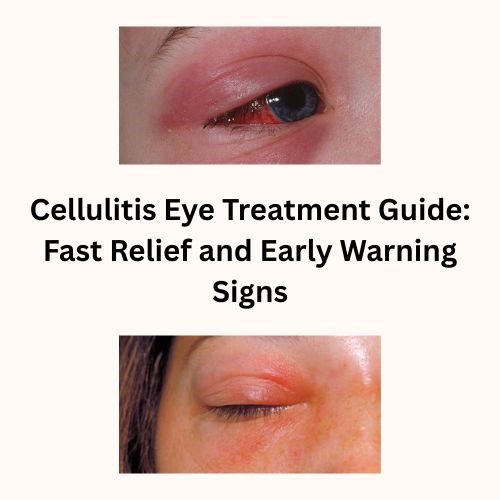Eye infections can be frightening, especially when they involve swelling, redness, or pain around the delicate structures of the eye. One of the most serious conditions affecting this area is cellulitis eye, a rapidly spreading infection that requires immediate attention. Without proper treatment, cellulitis around the eye can become dangerous, potentially affecting vision and even spreading deeper into the body.
This guide covers early signs, symptoms, and safe treatment options, and what you must do immediately if you suspect eye cellulitis. Early understanding is essential — especially because many people mistake it for a simple allergy or mild irritation. To help readers understand the fundamentals, some healthcare practitioners often start with a general overview like what is cellulitis symptoms, causes and infection to highlight why this condition is so important to treat early.
What Is Cellulitis Eye? Understanding the Basics
Cellulitis eye refers to an infection that develops in the eyelid or the tissues around the eye. This infection is most commonly caused by bacteria such as Staphylococcus aureus or Streptococcus species. It can occur after a sinus infection, after scratching the area, or even due to an untreated stye.
There are two main types:
Preseptal (Periorbital) Cellulitis
This affects the eyelid and skin around the eye but does not spread behind the eye. Symptoms are typically milder but still need urgent treatment.
Orbital Cellulitis
This is a much more serious infection that spreads behind the eye. It can threaten vision and overall health.
Whether it’s called cellulitis of the eye, eye cellulitis, or cellulitis around eye, the condition requires fast medical intervention.
Common Causes of Cellulitis on the Eye
Many situations can lead to cellulitis developing in the eye area, including:
- Sinus infections, especially bacterial sinusitis
- Eye injuries or trauma
- Insect bites near the eye
- Skin infections spreading upward
- Complications from styes or chalazions
- Bacteria entering through minor cuts or scratches
Children are more likely to develop preseptal cellulitis, while adults more commonly develop orbital cellulitis related to chronic sinus issues.
No matter the cause, the presence of cellulitis on the eye must never be ignored.
Early Warning Signs of Cellulitis in Eye
Eye cellulitis develops quickly, and early symptoms include:
- Redness around the eye
- Swollen eyelids
- Warmth or tenderness upon touch
- Pain when opening or closing the eye
- Fever or chills
- Discomfort around the sinuses
- Tearing or watery eyes
More severe cases of cellulitis in the eye may show:
- Eye pain with movement
- Difficulty opening the eye
- Bulging of the eye (proptosis)
- Reduced or blurry vision
- Headaches
- Severe swelling
If any of these signs appear, medical evaluation should happen immediately.
Cellulitis Eye Infection vs. Allergies: How to Tell the Difference
Because symptoms like redness or swelling can mimic seasonal allergies, many patients mistakenly delay treatment. However, allergies rarely cause:
- Fever
- Severe swelling
- Intense pain
- Difficulty moving the eye
A cellulitis eye infection progresses fast and becomes more painful over time, which is not typical with allergies.
Who Is Most at Risk for Cellulitis in the Eye?
Several groups have a higher risk of developing cellulitis of eye, including:
- Children under 6
- Adults with chronic sinusitis
- People with weakened immune systems
- Individuals with eczema or chronic skin irritation
- Anyone who recently had facial trauma
- Those with uncontrolled diabetes
While cellulitis can affect anyone, sinus-related cases are especially common in adults.
How Doctors Diagnose Cellulitis Eye
Diagnosis includes:
- Physical Examination
Doctors evaluate swelling, redness, and eye movement. - Blood Tests
These help detect infection levels. - CT Scan or MRI
Imaging determines whether the infection has spread behind the eye. - Eye Movement Tests
Limited movement may indicate orbital involvement.
Accurate diagnosis ensures correct treatment, especially because orbital cellulitis is a medical emergency.
Treatment Options for Cellulitis Eye
Treatment depends on severity and whether the infection is preseptal or orbital.
Antibiotics
For mild preseptal cellulitis, oral antibiotics are often enough. For more severe cases, intravenous antibiotics may be required.
Hospitalization
Orbital cellulitis almost always requires a hospital stay due to the risk of vision loss and complications spreading to the brain.
Sinus Drainage
If severe sinus infection is the underlying cause, doctors may drain the sinuses to stop bacterial spread.
Pain Relief
Prescribed pain relievers or anti-inflammatory medicines help reduce discomfort.
Monitoring Vision
Doctors observe eye movement and visual clarity daily to ensure that treatments are working.
Some people explore complementary approaches, and that’s where topics like treatment of cellulitis by natural herbal remedies may appear in discussions. These are not replacements for antibiotics but may support recovery when used safely with medical guidance.
Can Cellulitis Eye Be Treated at Home?
No — not without medical supervision.
While home care can support recovery, cellulitis requires prescription antibiotics. Delaying treatment increases the risk of:
- Vision damage
- Infection spreading to the brain
- Permanent eye complications
However, supportive care at home can ease symptoms while antibiotics work. Some people discuss options like cellulitis natural treatment stop skin disease, but again, these should only complement — never replace — medical intervention.
Preventing Cellulitis Around Eye
Because cellulitis can recur, prevention is essential:
- Treat sinus infections early
- Avoid rubbing or scratching the eye area
- Keep contact lenses clean
- Clean makeup brushes regularly
- Treat styes promptly
- Keep skin moisturized to reduce cracking
- Use protective eyewear during activities
Good hygiene plays a major role in prevention.
Cellulitis in the Eye in Children vs. Adults
Children
Most cases are preseptal and occur after minor injuries or sinus infections. Children usually respond quickly to oral antibiotics.
Adults
More likely to experience orbital cellulitis related to severe sinus disease. The condition can be more dangerous in adults and may require more aggressive treatment.
When Cellulitis Eye Becomes an Emergency
Immediate emergency care is needed if you notice:
- Eye bulging
- Severe fever
- Double vision
- Inability to move the eye
- Severe headache
- Vomiting
- Confusion
- Seizures
These symptoms may indicate the infection is spreading deeper.
Long-Term Effects of Untreated Eye Cellulitis
Ignoring the signs can cause:
- Permanent vision loss
- Optic nerve damage
- Brain infection (meningitis)
- Cavernous sinus thrombosis
- Facial disfigurement
With quick treatment, full recovery is expected in most cases.
Lifestyle Support During Recovery
During recovery, doctors often recommend:
- Rest
- Hydration
- Warm compresses for mild discomfort
- Following antibiotic instructions fully
- Avoiding contact lenses until cleared
At the end of recovery, some individuals consider complementary discussions about cellulitis herbal treatment to help support overall skin health, though these are not primary treatments.
Final Thoughts: Protect Your Eyes Early
Cellulitis around the eye is a serious condition, but early recognition and fast action lead to excellent outcomes. If you notice redness, swelling, or pain in the eye area, especially accompanied by fever or vision changes, seek medical treatment immediately.
By understanding early warning signs, knowing when to get help, and supporting your recovery carefully, you can protect both your eyes and your long-term health.




